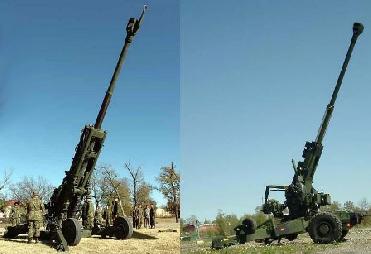
M777 Lightweight 155mm Howitzer (Left) and Bofors FH-77B05 Howitzer. BAE Systems Photo.
July 26, 1999 will go down in the Indian history as a day when the Indian armed forces achieved a glorious victory in the Kargil War.
With the help of joint Infantry-Artillery operation, the Indian Army fought bravely against all odds in the icy heights of Kargil.
India's victory in the Kargil conflict shows that the employment of artillery firepower has proved to be a decisive arm.
The 155 mm Bofors FH-77B, in the direct firing role, destroyed all visible enemy sangars and forced the enemy to abandon several positions. The guns therefore played a crucial role in facilitating that victory.
But the victory was short-lived as the company that made the guns - Sweden’s Bofors AB was soon embroiled deep into a boiling controversy. And today Bofors is split in two parts; BAE Systems Bofors and Saab Bofors Dynamics.
On the other hand, with the passing of time, India soon started its artillery modernisation programme i.e., plan to refurbish and upgrade Indian Army’s old unit of 155 mm FH-77B Bofors guns.
Stiff competition followed as defence and aerospace related companies came forward to answer the RFP issued by the Indian Ministry of Defence for its armed forces.
Bofors FH-77B05, Soltam TIG 2002, Denel G5/2000 were the three competitors to win the Indian Army contract for the acquisition of ultra light howitzers.
ST Kinetics, part of Singapore Technologies Engineering was blacklisted by the Indian Defence Ministry. The Singaporean firm was the only vendor offering around 150 152mm/52 calibre ultra light howitzers to meet the requirements of the Army.
Later, the South African company, Denel, also come under the scanner for corruption charges.
Due to repeated delay in the procurement of the light weight howitzers for various reasons including blacklisting of firms, corruption and Bofors dilemma the Indian government finally decided to purchase the howitzers through the foreign military sales route.
The Defense Security Cooperation Agency of USA notified Congress on Jan. 22 of a possible Foreign Military Sale to India of 145 M777 155mm Light-Weight Towed Howitzers with Laser Inertial Artillery Pointing Systems (LINAPS) and associated parts, equipment, training and logistical support for a complete package worth approximately $647 million.
USA was of the viewpoint that the proposed sale will contribute to the foreign policy and national security of the United States by helping to strengthen the U.S.-India strategic relationship and to improve the security of an important partner which continues to be an important force for political stability, peace, and economic progress in South Asia.
India has thus now moved closer to buying 145 ultra-light howitzers from the USA. Apart from 145 howitzers, the army wants to add 160 towed and wheeled guns.
The US howitzers will assist the Indian Army to develop and enhance standardization and to improve interoperability with US Soldiers and Marines who use the M777 as their primary means of indirect fire.
Besides the US Marine with 380 such systems and US National Guard with 273 of them, Australia (57 guns) and Canada (12) are the only other two foreign countries who have been supplied this state of the art military equipment by the USA.
The M777 Lightweight 155mm Howitzer (M777) is a 155mm towed gun approved by US navy as their next generation Medium Force weapon. The M777 incorporates innovative designs to achieve lighter weight, smaller footprint, and lower profile provides improved strategic deploy ability, tactical mobility, and survivability.
The procurement of the world’s lightest 155MM howitzers is expected to help India modernise its armed forces and enhance its ability to operate in hazardous conditions.
Comparison between M777 Lightweight 155mm Howitzer and Bofors FH-77B05:-
| Key Facts ** | M777 Lightweight 155mm Howitzer | Bofors FH-77B05 |
| Crew | 7 | 5 |
| Weight * | 10,500 pounds or less | 24000 pounds |
| Range | 30-40 km (assisted), 22.5-30 km (unassisted) | 40 km |
| Rate of fire | 5-8 rds/min | 3 rds/13 sec |
[* The difference in weight has a significant value in the tough terrains like mountains as for a soldier it’s a matter of life and death.
** Technical Specification collected from an open source]
- Courtesy:
SAAB Group
BAE Systems
Defense Security Cooperation Agency of USA
PIB, India
Global Security Website
 Previous Article
Previous Article












The Indian Air Force, in its flight trials evaluation report submitted before the Defence Ministry l..
view articleAn insight into the Medium Multi-Role Combat Aircraft competition...
view articleSky enthusiasts can now spot the International Space Station (ISS) commanded by Indian-American astr..
view article